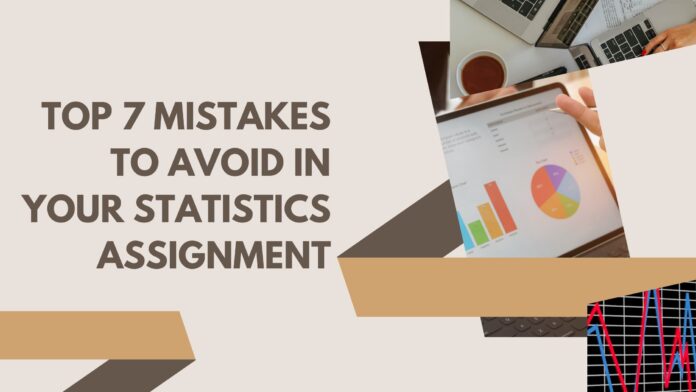Between integrating complex statistical formulas, software programs, and deadlines that seem to pile up, working on a statistics assignment can become overwhelming. While the concepts are simple to grasp, minor errors can cause you significant mark loss. Bad habits, from selecting an inappropriate technique to neglecting key sections of data analysis, can easily catch you out. These common mistakes that are out of sight until the results come out are the reason students seek help with assignments.
This article discusses the 7 mistakes students make in statistics assignments. Moreover, this guide will help you get it right, whether you are a novice to statistics or simply want to clarify your knowledge.
technira | ffamousparenting | theparktowers | footballteamlineups | datingrelationshipslove
Mistake: 1 Not Understanding the Assignment Question
The biggest and most common mistake students make is that they are not clear about what their assignment requires them to do.
Misunderstanding the objective
Most assignments will highlight a specific goal. For example, performing a hypothesis test, making an interpretation from a regression model, or summarizing descriptive statistics. If students cannot pinpoint the objectives, they will hand over a comprehensive report but will miss the big picture.
Ignoring specific guidelines
Professors might also include things like what software to use, word limits, formatting styles or even datasets that need to be used. This includes things like how you are submitting your assignment, or the way you present your assignment. If these points are not noticed, you might lose points even though the content is perfect.
Solution: Clarify and plan
Read the assignment brief more than a few times, emphasising the task and checking with your professor if you are in doubt. A perfect understanding of the task saves time, prevents rework and makes your final grade much better.
Mistake 2: Using the Wrong Statistical Approaches
Selecting the incorrect statistical tool is one of the biggest mistakes students make in statistics assignments. However, misuse of statistical methods will give erroneous results. These mistakes are prevalent due to the ambiguity about the type of data and how it may be applied, the research question, and the underlying assumptions of each test.
Ignoring assumptions
Different statistical techniques have some assumptions, such as normality, independence, equal, or similar variance. Without evaluating whether these elements hold, students frequently use a technique which can lead to distorting the results. Unless you check assumptions, your results may be incorrect.
Over-reliance on software
Tools such as SPSS, R, or Excel make analysis very easy. But without knowledge of the in-depth method, it can be deadly to depend on it. This results in many students entering data without being certain that the test applies to the given problem, leading to erroneous interpretations.
Solution: Learn and verify
It is important to know the purpose of each statistical test and what its requirements are. Right from the first step of running any analysis, while setting up the data, take some time out to see which method can work well on your data. If you are not confident, getting statistics assignment help online can help you with methods that are perfect for proficiency.
Mistake 3: Poor Data Handling and Cleaning
Proper handling of data is one of the most overlooked yet important steps in any stats assignment. However, quality is one thing that can so often be ignored during the preparatory steps associated with analysing data. Usually, raw data consists of inconsistencies, missing values, duplicates or errors, and this massively affects your results. The students skip this or rush through this step many times, leaving them to analyse the wrong information.
Failing to address missing or inaccurate entries
Datasets often contain missing values, and when not addressed appropriately, imputation, deletion, or the results can be off. Similarly, erroneous entries or different formats can undermine statistical computation.
Overlooking data types and coding errors
Other mistakes are related to types of variables, such as mislabeling categorical/numerical, and mixing up units and scales. Even a minor mistake like a confusion of a column name or a variable classification error can produce erroneous results!
Solution: Clean before you analyse
Always start your assignment with an exact data-cleaning process. Scan your data for problems, extreme values and missing values. Using summary statistics, visual tools like histograms or box plots, and consistency checks, to validate your dataset.
Mistake 4: Using Wrong or Incomplete Calculation
Manual calculation mistakes are one of the most frequent problems in statistics assignments. From misusing a formula to misreading a chart value or just putting an incorrect number on the calculator, these errors can completely spoil the accuracy of your assignment. A simple mistake can lead you astray and make you draw the wrong conclusions.
Misuse of statistical formulas
At this point, students are making formulas without knowing what they mean, like population standard deviation instead of sample standard deviation or z-score instead of t-score. Such errors are indicative of not having conceptual clarity and results in distortion and misinterpretation.
Solution: Review and double-check
Take a moment after making calculations to check through every step. Be cautious in the use of digital methodologies, and wherever possible. When in doubt with a formula, check back in your textbook or lecture. Mathematical calculations’ accuracy exhibits a firm understanding of statistical thinking and attention to detail.
Mistake 5: Ignoring Data Interpretation
Most of the students just show the output like mean values, standard deviations, the output of the regression, or the p-value, without explaining what the numbers mean. Though precise calculations are relevant, it is your interpretation that exhibits the real understanding.
Skipping the “so what?” question
Just because you say that “p < 0.05” does not mean anything unless you qualify what that means for your hypothesis or research question. Does it validate your conviction, or rekindle your scepticism? Your assignment looks incomplete without this explanation, no matter how perfect the numbers are.
Drawing unsupported conclusions
Concluding a cause based on correlation, or generalising without sufficient statistics. Such mistakes can damage the credibility of your work.
Solution: Explain, do not assume
Immediately after your analysis, provide a short narrative of what the results mean. Make sure you extrapolate every conclusion to the purpose of your assignment. However, if you come across any kind of trouble, getting help with assignment from an expert is recommended. The ability to think critically about your results can take simple stats and make them an impressive academic insight.
Mistake 6: Poor Presentation and Formatting
A good statistics assignment presentation can make or break your scores, even if your calculations and interpretations are on point. If you submit a messy spreadsheet, a graph without axes, or a paper with a mix of fonts and point sizes, professors literally cannot follow your work. An organised, easy-to-read and professional-looking work showcases your eye for detail.
Missing visual clarity
In statistics, charts, graphs, and tables should be forbidden and only permitted to be shown when they are well-formed. These include using the wrong type of chart, not labelling axes, or including visuals with no real value. If you do not label or include short descriptions, your visuals may confuse instead of clarifying.
Ignoring citation and formatting styles
The format of any assignment is crucial, and a lot of students overlook this aspect. This leads to reducing your overall quality of submission due to missing references, improper in-text citations, and inconsistent headings.
Solution: Make it easy to read
Always proofread and format your assignment before submission. Include bullet points and headings, and label your visuals correctly. If the structure is where you find it hard to be on track, statistics assignment help online will give you an idea of how the inside will match the outside.
Mistake 7: Plagiarism and Lack of Originality
Plagiarism is an illegal practice where you copy others’ work without proper referencing and recognition of the source, and this is the most grave form of academic dishonesty in most tasks. That might mean copying equations, methods of analysis, or even whole datasets and descriptions from the internet or people.
Using sample solutions as your own
Most students depend on sample assignments and online tutorials to learn statistical processes. These resources are awesome for learning, but submitting them as your work is a huge no. Professors usually know the common sources and will quickly recognise a duplicate.
No personal insight
Some student voices are not added, even with a correct analysis of the data. It often reduces the assignment to a robotic presentation of textbook definitions or generic explanations of concepts without any original thought or useful insight. How you interpret, present, and discuss your work is what makes it yours.
besttimefortravel | beforeitsnewscom | famesfizz | anylnstallations | cinefamez
Solution: Be authentic
Limit your reading and work toward your ideas. Writing original work is rewarded more in grades and helps develop abilities that will last a lifetime.
Conclusion
Statistics assignments are not mere number crunching; they require precision, interpretation, and presentation. As we have seen, making a mistake like misunderstanding instructions, using the wrong methods, skipping the data cleaning, and the interpretation step are crucial elements that can influence your performance by a lot or very little.




